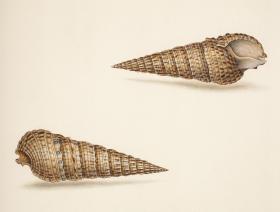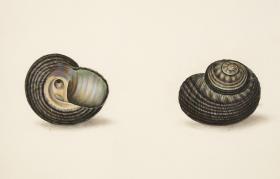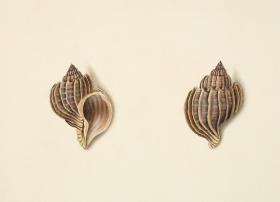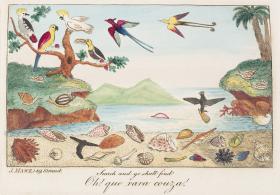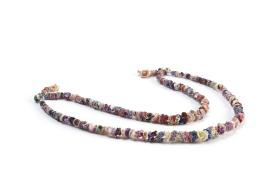When we walk along the beach, many of us are mesmerised by the array of shells tossed up by the whims of waves. This chance release of treasure from the ocean can activate an almost absent-minded process of collecting, assessing and discarding in a quest for the perfect shell.
Throughout history, seashells have been used for adornment and in ceremonies, collected for science, prized by collectors, and treasured as ornaments. With their infinite variety of shapes, sizes, textures and colours, they are the subject of countless guidebooks and catalogues, and often feature in art and design.
For millennia, Aboriginal people have used shells in initiations and other rituals, for fishhooks and other tools, and as adornments to indicate social status. Evidence also suggests that Aboriginal people in Western Australia used shells in their trade with neighbours.
During the fifteenth and sixteenth centuries, shells were considered highly desirable ‘curiosities’ throughout Europe. They were depicted in the woodcuts of early printed books such as Ortus Sanitatis, a natural history encyclopedia published in Germany in 1491.
Over the next two centuries, collectors were gripped by a madness for shells, fed by European voyages of discovery and colonial trade. In this Age of Enlightenment, the open exchange of ideas, information and objects was encouraged. Shells were among the natural history specimens brought back to Europe by ships’ crews — including scientists or naturalists on voyages — and sold to dealers and collectors.
When rivals France and Britain sent expeditions to chart the southern coastline of New Holland, as the Dutch had named the Australian continent, the British were first to complete the task. ‘[I]f we had not been kept so long picking up shells and catching butterflies ...’ French naval officer Louis de Freycinet later told Matthew Flinders, ‘you would not have discovered the south coast before us.’
This obsession with shells was referred to by philosopher Jean-Jacques Rousseau as conchylomania (from ‘concha’, the Latin word for shellfish). It was a condition shared by many wealthy collectors and members of the European aristocracy, who displayed their precious spoils in cabinets of curiosity.
Well-heeled natural history enthusiasts also supported the eighteenth century’s explosion of exquisitely illustrated books, which included books on conchology. The State Library of NSW recently acquired a lavish first edition of Thomas Martyn’s The Universal Conchologist. Published in London in 1784, its two volumes contain 80 illustrations drawn by Martyn and engraved and hand-coloured by a series of young men he trained as natural history artists.
Martyn purchased many of the shells featured in the book from the crews of the Resolution and Discovery on James Cook’s third voyage. Also represented are shells belonging to the Duchess of Portland, a renowned collector, to naval officer and governor John Hunter and to Scottish physician George Fordyce. Ultimately, many of these natural history collections were dispersed at auction and some specimens found their way into museums where they could be consulted by scientists, artists, designers and engineers.
In 1804 British mineralogist John Mawe published A Short Treatise on Natural History, which would go into several editions and eventually became the Shell Collector’s Pilot, the world’s first shell collecting guide. The book provides directions on where to find the finest shells, together with advice on cleaning and packing them.
The only recorded copy of Mawe’s first edition is held in the Library. At the front of the third and fourth editions, a striking hand-coloured engraving shows a flock of birds — including a sulphur-crested cockatoo — above a beach strewn with brightly coloured shells and coral. Captioned ‘Search and ye shall find’, the drawing was intended ‘to tempt the traveler, and rouse his mind to contemplate on the beauties of the deep’.
As well as a symbol of nature’s beauty, shells can be used to preserve a memory of a person, place or moment in time. Made into artworks or jewellery, they become a tangible connection to the past and have the power to elicit strong emotions.
‘I have got a new madness,’ the English artist Mary Delaney wrote to her sister in 1734. ‘I am running wild after shells ... the beauty of shells is as infinite as flowers.’ Delaney, who was best known for her paper botanical collages, added shellwork — which had first appeared in the previous century — to her range of arts and crafts. She often stayed with her friend the Duchess of Portland, a skilled conchologist, field collector, patron of shell books, and owner of one of the largest shell collections in the world.
Shellwork became a popular craft for women in the Victorian era, not least in the Australian colonies. From the late 1800s, the Aboriginal women of La Perouse made a variety of shellwork objects such as heart-shaped boxes and baskets, which were often displayed at agricultural shows and fairs, and sold as souvenirs to visiting tourists. The techniques were perfected through the generations to create works of symbolic significance.
Bidjigal elder and artist Esme Timbery carries on the work of her great-grandmother Queen Emma Timbery and the La Perouse community. Her delicate works of art — including jewellery boxes, slippers and models of the Sydney Harbour Bridge — can be found in many private and public collections. In 2018 Timbery made a shellwork model of the La Perouse Mission Church for the Library’s exhibition Sydney Elders: Continuing Aboriginal Stories. ‘Our lives revolved around that little church,’ Timbery recalled. ‘We were there all the time. It was like a second home to us.’
In November 1946 Jean Devanny sent her friend and fellow Australian writer Marjorie Barnard a necklace made from shells she had painstakingly collected while working with noted naturalist Dr Hugo Flecker in North Queensland. Devanny spent the last two decades of her life there, writing books and articles and collecting coral and shells for Flecker’s North Queensland Naturalists’ Club.
‘It has taken me four years to collect sufficient shells to make up this necklace!’ she wrote to Barnard. ‘[T]hey are so difficult to thread, I only bothered about it because I wanted to give you something unique to suit your own lovely character.’
Two weeks later Marjorie responded, ‘The necklace came today and it is very beautiful but it isn’t that that moves me so deeply. So much care and time went into its making that no one would do it except for love, something that cannot be bought and is rarely given.’ Marjorie kept the necklace until her death 40 years later, and it was given to the Library by her friend Vera Murdoch in 1989.
In addition to jewellery, shells have been used in interior design, including for the exuberant motifs of the rococo period that began in France in the 1730s. The geometry of shells almost seems architectural, which may have been part of their attraction for Australian photographer Max Dupain. Along with his photographs of modernist buildings, Dupain’s photographic archive at the Library contains many images of shells, some artfully arranged and others in their natural environment.
Shells have a sensuality about them that also attracts artists and collectors. They are often seen as symbols of fertility and sexuality — their smooth rounded bumps can resemble a pregnant belly; the spiral of a periwinkle shell can look like the breast of a woman. Shell openings have been said to resemble female genitalia, particularly the long mouth of a cowrie shell.
Nowadays, of course, the ethics of shell collecting is a consideration, not least because they house living creatures. But they remain as desirable today as they were thousands of years ago. People still stroll along the beach fondling prized selections in their fingers before either returning them to the sea or slipping them into a pocket for safekeeping. The calming effect of collecting shells makes this a pastime that will endure as long as there are shells to collect.
Sarah Morley, curator.
This story appears in Openbook autumn 2021.

